Posts Tagged ‘concrete floor’
Your Floor Is Only As Good As Your Platform
While carpet and carpet pads hide a lot of deficiencies found in typical subfloors, things like wood, tile, and LVT/LVP flooring reflect those deficiencies: Uneven joints between planks, sheets and tiles; Floors with obvious slopes, bumps, ridges and/or rolls, etc. These deficiencies can quickly turn what was anticipated to be a beautiful LVP floor into…
Read MoreFlooring Won’t Stick To Gypsum?
Why Won’t It Stick? Many installers experience a huge problem when applying flooring on new or old gypsum substrates: their glue or patch just won’t stick to the slab. More often than not, this is attributed to gypsum lacking the integrity to accept many floor coverings. Thankfully, there is a simple method for making gyspum…
Read More2013 TCNA Handbook Addresses Concrete Slabs that Do Not Measure Up
“The vast majority of commercial tile installations, and a significant percentage of residential ones, are bonded directly to concrete slabs. This means when concrete workers are finishing slabs slated for tile, they’re forming the tile installers’ substrate. The flatness of these slabs — the concrete installer’s workmanship, effectively — can be measured in different ways.…
Read More“Relative Humidity Testing for Concrete: ASTM F2170 Becoming the Preferred Method”
“Why do testing? The simplest reason why is to follow the industry standard: ASTM F710, Standard Practice for Preparing Concrete Floors to Receive Resilient Flooring. The language in the standard is very simple, and uses legal terms like “all,” “shall” and “regardless” that don’t allow for any wiggle room. “All concrete slabs shall be tested for…
Read More
